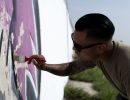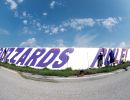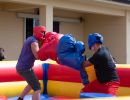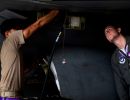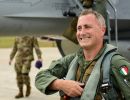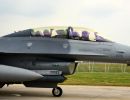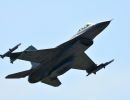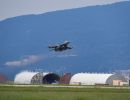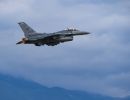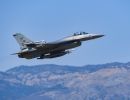I. GENERAL DESCRIPTION OF THE MISSION
II. COMPOSITION OF THE FORCE
III. NARRATIVE SUMMARY OF OPERATION
IV. RESUME OF OPERATION
V. ANALYSIS OF THE COMPLETE OPERATION
TAB A. OPERATIONS
TAB B. INTELLIGENCE
TAB C. LOGISTICS
TAB D. COMMUNICATIONS
TAB E. OTHER
THIS PAGE BY ITSELF IS UNCLASSIFIED
PART I GENERAL DESCRIPTION OF THE MISSION: (Secret)
Personnel of the 510th Tac Ftr Sq deployed from England AFB, Louisiana, to Clark AB, Republic of the Philippines, in accordance with AF Strike OPlan 8, Designation of this TDY was Lima Mike 26. Mission of the unit was to assume SIOP posture at Clark AB and at Tainan Air Station, Taiwan.
PART II COMPOSITION OF THE FORCE: (Secret)
The squadron deployed from England AFB with 29 officers and 182 airmen. Upon arrival at Clark AB this unit was briefed by the 90th Tac Ftr Sq. The 510th Tac Ftr Sq assumed SIOP posture with 18 aircraft. Through the process of having to supply attrition aircraft to other F-100 units in Southeast Asia, the unit redeployed with 13 aircraft.
PART III NARRATIVE SUMMARY OF THE OPERATION: (Secret)
1. Personnel were airlifted to Clark AB, Republic of the Philippines, via three MATS C-135 aircraft. These aircraft departed England AFB, Louisiana, on 5, 6, and 7 May. No problems were encountered.
2. Upon arrival at Clark AB, the unit personnel were briefed by the departing squadron (90th Tac Ftr Sq) and by the 405th Ftr Wg personnel. The 510th Tac Ftr Sq then assumed the SIOP posture.
3. In addition to the SIOP commitment, this unit deployed aircraft and pilots to Da Nang AB, Republic of Vietnam, starting 20 May 1965. These resources were used to augment the strike force of the 416th and 615th Tac Ftr Sqs. Combat missions were flown by the 510th personnel until the end of June when 2nd Air Division put out the edict stating that only personnel assigned to units in Vietnam would be allowed to fly combat missions. However, unit aircraft were continuously used to augment theater resources. This imposed a steady drain upon flying time and reached a point where one additional aircraft would have meant a degradation of our SIOP posture. Unit aircraft were also being transferred to other units to replace combat losses. Upon departure at the end of the rotational period, this unit redeployed with 13 aircraft. The minimum number of aircraft required to maintain posture is 12. Due to outstanding scheduling and maintenance, this commitment was accomplished at all times.
4. During this period two pilots were upgraded to combat ready status and one additional pilot completed TN and CR training with the exception of AIM-9 training. AIM-9 weapons were not available for release. One pilot completed Phase I training after returning from Southeast Asia on an FAC assignment. Lack of tankers hindered both CR and Phase III continuation training.
5. All unit aircrews received invaluable training by getting the opportunity to fly combat sorties in SEA even though we were denied the opportunity of getting more missions.
6. Redeployment was started on 17 August 1965, utilizing 4 tankers and 13 F-100 aircraft, from Clark AB to Guam. Support personnel were airlifted utilizing five C-135 aircraft. All fighter aircraft launched on schedule for a parallel orbit rendezvous with the tankers. Two waves were launched of 8 and 5 aircraft respectively. All aircraft completed this leg without incident.
7. On 19 August, after a 24 hour hold for weather in the refueling area, two waves of 8 and 5 fighters were launched from Guam for Hickam AFB, Hawaii, using buddy takeoff system. One aircraft in the first cell snapped a probe while refueling on the first hookup, necessitating 1 tanker and cell of two fighters returning to Guam. All other fighters proceeded as planned to Hickam AFB. The two fighters with tanker escort arrived from Guam the next day after some outstanding repair work by unit EST "A". After about 36 hours on the ground at Hickam, all 13 aircraft were launched on schedule for England AFB. This leg was completed with the 2nd cell landing just prior to dusk on 20 August. Remaining support personnel and equipment arrived early in the morning and later in the evening of 21 August.
PART IV. RESUME OF OPERATION: (Secret)
1. Mission: To assume SIOP commitment under AF Strike OPlan 8
2. Sorties Scheduled: 1140
3. Sorties Flown: Deployment 0, Employment 992, Redeployment 41
4. Hours Flown: Deployment 0, Employment 1586, Redeployment 209
5. In-commission Rate: 79%
6. Abort Rate: Air .96% Ground .97%
7. Average NOR Maint: 6%
Average NOR Supply: 15%
8. 168 pilot combat sorties and 242.3 pilot combat hours flown.
9. 56 pilot combat support sorties and 115.25 pilot combat support hours flown. These were acquired to and from South Vietnam ferrying aircraft for all F-100 units in SEA.
PART V. ANALYSIS OF THE COMPLETE OPERATION: (Unclassified)
TAB A OPERATIONS
TAB B INTELLIGENCE
TAB C LOGISTICS
TAB D COMMUNICATIONS
TAB E OTHERS
ALLEN S. NELSON, Lt Col, USAF
Commander
TAB A OPERATIONS
ANALYSIS: (Secret) The primary mission of the 510th Tac Ftr Sq was to support the SIP posture. This mission was accomplished for the entire period. Secondary mission was to accomplish normal training. A non programmed benefit was achieved through the combat experience achieved. Some factors are discussed below.
PROBLEM: (Secret) Considerable difficulty was encountered due to the requirement by 13th Air Force and 2nd Air Division of supplying replacement aircraft whenever aircraft in SEA fell below a certain number (18 per squadron). Besides scheduling difficulties another problem was encountered by depleting aircraft to the absolute minimum required to support the SIOP commitment. When unit possessed aircraft falls below 15 aircraft, it is extremely doubtful if the SIOP commitment can be supported. This minimum of aircraft does not allow sufficient flying time to keep aircrews proficient.
RECOMMENDATION: (Secret) That the TAC/PACAF agreement be reexamined and re accomplished if the SIOP program is to be maintained. The unit supporting SIOP must be maintained as an integral unit and not have its resources drained away. This is essential in order to properly maintain the SIOP posture plus having sufficient aircraft to allow pilots to stay proficient.
PROBLEM: (Secret) Tanker Support. This unit received 3 out of 14 tankers requested to support normal training and redeployment training. These tankers were cancelled for a variety of reasons, most predominant of which were due to higher priority missions. Many times the tankers were cancelled just prior to takeoff. Valuable training was lost then due to range non availability.
RECOMMENDATION: (Secret) That AAR training requirements be waived for units supporting SIOP when AAR is not required in the mission. That either the pre deployment refueling requirement be eliminated or sufficient priority be placed upon it to assure that this training is available.
PROBLEM: (Secret) Dart storage at Clark AB had been accomplished in an unsatisfactory manner. This allowed dart wings to soak up moisture. When trying to launch the water soaked dart it either fell apart on launch or broke up after launch. The moisture apparently caused deterioration of the bonding. After three attempts all remaining darts were inspected and condemned as unfit for usage.
RECOMMENDATION: (Secret) That darts be stored properly and protected from excessive moisture.
PROBLEM: (Secret) AGM-12 and AIM-9 Training. This unit was unable to accomplish any missile launch training due to non availability of missiles. The close proximity of both air-to-air and air-to-ground ranges would provide an excellent opportunity to accomplish this training while deployed at Clark Air Base. This would certainly be a step toward relief on some of the extensive TDY commitments on the tactical aircrews and necessary support personnel.
RECOMMENDATION: (Secret) That the TAC/PACAF agreement be amended to include necessary AIM-9B and AGM-12 training units be made available for units at Clark.
PROBLEM: (Secret) Clark AB is presently overloaded and very crowded. The 405th Ftr Wg did the best possible but conditions were still unsatisfactory considering both sanitary and morale aspects.
TAB B INTELLIGENCE
Forwarded under separate cover.
TAB C LOGISTICS
MAINTENANCE ANALYSIS: (Secret)
1. Organization: While TDY as a ROTE squadron on Clark AB, the maintenance complex functions as the standard single squadron concept. Span of control was a materiel officer as overall supervisor, as aircraft maintenance officer who supervises the flight line and periodic maintenance function, and an A&E maintenance officer to supervise the armament and electronic specialist areas. A supply sergeant supervised the supply function and worked directly for the materiel officer. A scheduler, records clerk, and a maintenance clerk were integrated into the 405th Ftr Wg Chief of Maintenance functions. Quality Control Inspectors were also integrated with the 405th Ftr Wg QC Branch but worked primarily on ROTE aircraft.
2. The 405th FW DCM has given the Senior TAC ROTE F-100 Maintenance Officer at Clark the over-all responsibility for monitoring all F-100 maintenance activities in Southeast Asia. Since Clark AB is the main operating base for F-100’s in SEA, this officer has overall responsibility for all maintenance function for both ROTE and CASF units.
3. Field maintenance and armament and electronics specialist were integrated with 405th FMS and AES host organizations for dispatch and control.
4. Maintenance Resume: The following summaries of maintenance status were achieved during the tour:
a. Average acft possessed 18
b. Average acft ops ready 15
c. Average OR rate 79%
d. Average NORM 6%
e. Average NORS 15%
f. Hours flown 10 May-12 Aug 1586 hours
5. Squadron fleet time was maintained at an average of 110 hours. Ten (10) periodic inspections, eleven (11) 100 hour post flights, and nineteen (19) operationally ready spot inspections were completed. Average flow time for periodic inspections was five work days on a two shift basis.
6. The 510th TFS loaned aircraft to F-100 CASF squadrons in South Vietnam during this period which reduced the local availability by 25%. A total of 297 combat hours were flown by aircraft of this squadron. Three aircraft received major structural battle damage and one received minor damage during this period. No aircraft were lost or destroyed.
7. Personnel of the 510th augmented CASF squadrons operating in the RVN. Two munitions loading teams, eleven crew chiefs, and two communications technicians supplemented the 416th and 615th TFS at Da Nang AB, RVN, from 25 May through 30 June, 1965.
8. Four practice ORIs were called during this period. Each involved only the SIOP loading and simulated launch of the force. All loading times were met satisfactorily. Some difficulty was encountered with cartridge starter reliability from a runway alert status. Cause for failure varied between bad cartridges, dirty cartridge breech firing pins, and bad electrical circuits. A continuing program of regular circuits checks and breech cleaning cycles was established to insure reliability. As an additional precaution, sufficient MA-2 starting units were made available to the runway alert areas to give immediate backup in case of cartridge failure.
9. Quality Control Statistics:
a. Periodic Inspections 10
Average Red Crosses Disc. 2.1
Average Red Diagonals Disc. 19.4
b. Post Flight Inspections 11
Average Red Crosses Disc. 1.2
Average Red Diagonals Disc. 13.6
c. Operational Readiness Inspections 19
Average Red Crosses Disc. 1.7
Average Red Diagonals Disc. 11.2
d. Quality Control inspections were made on fifty (50) J57-21 engines following PE inspections, including engines for all SEA bases’ F-100 squadrons.
e. Quality Control spot checks were accomplished immediately upon an aircraft’s return from SEA, which accounts, in part, for the relatively high discrepancy rate for OR aircraft.
10. Redeployment: Redeployment of maintenance teams and equipment was made the responsibility of a single NCO. He assembled all required equipment, packed mobility boxes, and compiled load lists and manifests to the point that all was in readiness upon arrival of airlift aircraft. The mobility NCO then supervised personnel manifesting cargo and personnel loading. Considering the equipment shortages existing, mainly because of the time it had been in the theatre, the move through en route bases was highly satisfactory.
11. Only one maintenance problem of consequence was encountered during the redeployment. This was the loss of a refueling boom after the flight departure at Guam. Tearing of the boom from the spar fitting, which damaged hydraulic lines and the external tank, required part replacement beyond the FAK scope. With PACAF approval, required parts were cannibalized from aircraft previously grounded at Guam. Through the extraordinary efforts of maintenance teams, working in shifts, this aircraft was repaired and launched in less than 24 hours.
PROBLEM: (Secret) Upon arrival of this squadron to assume the commitment, control and dispatch of specialist personnel was a problem. Due to lack of facilities, communications, and transportation, all specialists worked without dispatches from the flight line area. This did not provide continuity or availability and contributed to a lack of control by AVC. An attempt was made to setup a dispatch center utilizing line personnel. This was unsatisfactory due to lack of communications. On 15 June this condition was improved by use of allocated space in an adjacent field maintenance hangar and providing one telephone to dispatch all specialists for F-100, F-102, B-57, and F-4c aircraft.
RECOMMENDATION: (Secret) The TAC/PACAF agreement should be revised to clearly define the integration of ROTE squadron personnel into the host maintenance complex. If total integration is necessity, responsibility for providing shop space, dispatch and control of field maintenance, A&E, and munitions specialists must be assumed by the host wing. The TAC ROTE squadron should be considered a PCS organization and receive equal base support and attention as other similar squadrons, even though the unit is changed at regular intervals. This would relieve many problems of housing, transportation, supply accounts, facility utilization, and equipment pooling now encountered.
PROBLEM: (Secret) Non powered equipment available to the TAC ROTE function was unsatisfactory condition. Equipment deployed to the theatre, from TAC assets for many months had deteriorated to unserviceable condition. Identity of property belonging to specific units had been lost through the many rotations.
RECOMMENDATION: (Secret) That a standard TAC/PACAF procedure for control and identity of equipment remaining in place in the theatre through several rotations be adopted and closely monitored.
PROBLEM: (Secret) The jet engine shop did not have special tools and equipment necessary to provide fully serviceable engines. Afterburner actuator adjustment tools were locally manufactured. Nozzle measurement tools were also manufactured in the machine shop. A condemned PR7 absolute pressure gauge was located and locally repaired and calibrated to provide more accurately trimmed engine, both on the test cell and aircraft initial trim.
RECOMMENDATION: (Secret) That a standard TAC/PACAF procedure for control and identity of equipment remaining in place in the theatre through several rotations be adopted and closely monitored. (This paragraph appears to be a duplicate of the one above but, is correct as written on the microfilm.)
PROBLEM: (Secret) The aircraft trim pad facility on Clark AB is totally unsuitably located and is an inadequate facility. Its location is two miles from the fighter operations and maintenance area. It is utilized by F-100, F-102, and F-4c aircraft on the base but only accommodates a single aircraft. Towing an aircraft to and from the pad, through highly congested parking areas and across the active runway is time consuming and hazardous. For initial trim of newly installed engines, three (3) to five (5) hours are consumed if no problems are encountered.
RECOMMENDATION: (Secret) That Clark AB plan and construct a multiple trim facility adjacent to the fighter maintenance area.
PROBLEM: (Secret) Hangar space for a periodic maintenance facility is inadequate for the number of periodic docks needed. This shortage leaves no space for unscheduled maintenance. This is particularly hazardous when aircraft must be jacked in unsheltered areas. It also created problems in electronics equipment to be exposed to the elements while maintenance is performed in unsheltered areas.
RECOMMENDATION: (Secret) That Clark AB provide at least temporary shelters in sufficient numbers to meet mission requirements and provide for safe working conditions.
PROBLEM: (Secret) The munitions shop on the flight line consisted of a single open end Quonset hut with no lights. This created problems of corrosion on tools and munitions. Lack of lights created unsafe night operating conditions.
RECOMMENDATION: (Secret) That Clark AB rehabilitate present structure to provide shelter and security for munitions in the holding area. This rehabilitation should include lights in the building. This holding and storage area immediately adjacent to the flight line operations is a necessity to meet SIOP commitments.
SUPPLY ANALYSIS: (Secret)
1. Organizations: The supply section was organized and supervised by an NCO. The unit included an expedite call-in section, a kit control section, and an issue section. All requirements to Base Supply were called in against an established F-100 account. This unit supported, with CASF augmentation, the periodic maintenance function of four (4) F-100 squadrons. Approximately 3500 requests were made to Base with an issue rate of 85%.
2. Mobility Supply Kit: The squadron MSK, which supported four (4) periodic maintenance docks, plus the squadron flight line area, was maintained at better than 91% filled.
3. Problem Areas: Most supply problems encountered were the result of the pipeline time to SEA, and the abnormal aircraft utilization rates in the area. Each problem encountered was referred to the F-100 WSIO and expedited action was received.
PROBLEM: (Secret) A facility problem existed for storage of mobility weapons. No facility existed on base and no base unit would assume the responsibility. The problem was temporarily solved to utilizing a CONEX box drawn from the BX office.
RECOMMENDATION: (Secret) That Clark AB be required to provide a facility or designate an organization that will store TAC mobility weapons in possession of ROTE personnel while on base.



























